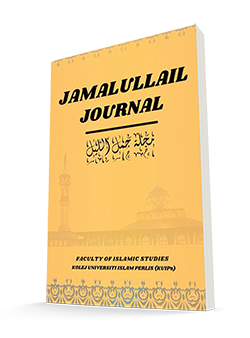Analisis Fatwa Sarjana Islam Mengenai Kepercayaan Nabi Muhammad Saw Diciptakan Dari Cahaya
Analysis Of Scholarly Fatwas On The Belief That Prophet Muhammad Saw Was Created From Nur
Keywords:
Fatwa, kasyaf, mustalah hadith, mawdu’, nur MuhammadAbstract
The fatwa asserting that Prophet Muhammad PBUH was created from nur (light) has spurred varying opinions among scholars. Simultaneously, the notion that Prophet Muhammad PBUH was created from nur has instigated numerous negative implications within the Islamic community, persisting from ancient times to the present day. The primary objective of this article is to examine global scholars' fatwas regarding the nur of Muhammad and to determine its alignment with the teachings of the Quran and al-Sunnah. This research adopts a qualitative methodology, obtaining data through document analysis referencing tafsir books, creed, contemporary fatwas, among other sources. The document analysis method utilised descriptive, deductive, and comparative approaches. The study findings reveal the viewpoint of a second group of scholars who refute the concept of the Prophet PBUH being created from light, as per the narration of Jabir RA, arguing that this hadith is fabricated (mawdu’). The faction asserting the authenticity of this concept based on its meaning or through spiritual intuition (kasyaf) is deemed unacceptable, as it lacks the requisite substantiation according to the principles of hadith verification in the field of mustalah hadith. The light referenced in the hadith concerning the dream of the Prophet PBUH's mother has never conclusively proved that the Prophet PBUH was constituted of light; rather, it elucidates the light of faith that he brought forth to guide humanity.
Downloads
References
Al-Quran
Abdul Monir Yaacob. (1998) Perkembangan Institusi Mufti Di Malaysia. Kuala Lumpur: IKIM
Abu Jayb, Sa’di .(1988). al-Qamus al-Fiqhi Lughatan Wa Istilahan. Dimasyq: Dar al-Fikr.
Abu Syadi, Ibrahim.(2008). Al-Rad al-‘Alami Ala al-Syubuhat Fi al-Aqidah wa al-Tasawwuf. Iskandariyyah; Dar al-Itqan.
Al-Albani, Muhammad Nasir al-Din. (1992). Silsilah al-Ahadith al-Sahihah. Al-Riyad: Maktabah al-Ma‘arif.
Al-Alusi, Syihab al-Din Mahmud .(1270H). Ruh al-Ma’ani Fi Tafsir al-Qur’an al-Azim Wa al-Sab’i al-Mathani. Dar ihya’ al-Turath al-Arabi.
Ahmad Hidayat Buang. (2016). Memperkukuh Kredibiliti Institusi Fatwa Dalam Menghadapi Cabaran Semasa Di Malaysia. Isu-isu Kefatwaan Kontemporari 2016: Fiqh Kontemporari Dalam Menepani Realiti Semasa Masyarakat Malaysia. Institute of Advanced Islamic Studies. Kuala Lumpur.
Al-Baidawi, Abu Said Abdullah bin Umar. (1418H). Anwar al-Tanzil wa Asrar al-Ta’wil. Beirut: Dar Ihya’ al-Turath al-Arabi.
al-Bukhariyy, Abu Abdullah Muhammad ibn Ismail ibn Ibrahim ibn al Mughirah ibn Baddizbah al-Jufiyy. 2000. Sahih al-Bukhariyy. Damsyik: Muassasah al-Risalah Nasyirun.
Al-Ghumari, `Abdullah b. Muhammad (2004), al-Rasail al-Ghummariyyah Mursyid al-Ha’ir li Baya Wad`i Hadith Jabir. Beirut: Dar al-Masyari` li al-Tiba`ah Wa al-Nasyr Wa al-Tawzi`
Al-Harari, Abdullah. (2001). Risalah Fi Butlan Awwaliyyah al-Nur al-Muhammadi. Beirut: Dar al-Masyari‘ Li al-Tiba‘ah.
Al-Fakhr Razi, Muhammad bin Umar. (1981). Mafatih al-Ghaib. Beirut: Dar a-Fikr.
Ibn Hajar al-`Asqlani, Ahmad b. `Ali (2001), Fath al-Bari Syarh al-Sahih al-Bukhari. Kaherah: Darr al-Rayyan li al-Turath.
Ibn Kathir, Ismail bin Umar bin Kathir .(1999). Tafsir al-Quran al-Azim. Jil.1 dan 2. Tahqiq: Sami bin Muhammad al-Salamah. Dar Tayyibah.
Ibn Manzur. (1956). Lisan al-Arab. Beirut: Dar al-Beirut.
Ibn Rushd. Muhammad bin Ahmad bin Rushd. (1987). Fatāwa Ibn Rushd. Jil. 3. Beirūt. Dār al-Ghurūb al-Islāmī.
Ilmi, Muhammad Taj. (1997). Al-Ijtihad. Beirut: Dar Al-Zahra’.
Al-Hallaj, Abu al-Husain bin Mansur. (t.th). Al-Tawasin. T.pt.
https://fiqh.islamonline.net/, Dilayari pada 10 Oktober 2022.
Abd Aziz bin Baz. (2022). https://binbaz.org.sa/fatwas. Dilayari pada 11 Oktober 2022.
Uthmain. (2022). https://binothaimeen.net. Dilayari pada 11 Oktober 2022.
Al-Juma’ah, Ali Muhammad. 2006. Al-Bayanul qawim li tashih ba’dhil mafahim. Al-Qahirah: Dar al-Sundus
Muhammad Rawwas & Hasin Sadiq Qasibi.(1405H/1985M). Mu‘jam Lughah al-Fuqaha’. Amman: Dar al-Nafa’is.
Al-Qaradawi, Yusuf.(1408H). Al-Fatwa Bayna Al-Indibat Wa Al-Tasayyub. Misr: Dar Sahwah.
Al-Qaradawi, Yusuf.(1990). Madkhal Li Dirasat al-Shari‘ah al-Islamiyyah. Kaherah: Maktabah Wahbah.
Al-Qaradawi, Yusuf.(1999). Fatwa Antara Ketelitian dan Kecerobohan. Selabor: Thinker’s library.
Al-Qurtubi, Muhammad bin Ahmad bin Abu Bakar. (2006). Al-Jami’ Li Ahkam al-Quran. Jil. 6. Beirut: Mu‘sasasah al-Risalah.
Rayyan, Ahmad Ali Taha .(1994). Dawabit al-Ijtihad Wa al-Fatwa. Kaherah: Jabhah Ulama al-Azhar.
Reda, Muhammad Rasyid. (2005). Fatawa al-Syeikh Muhammad Rasyid Reda. Beirut: Dar al-Kitab al-Jadid.
Al-Sa‘di, Abd al-Rahman bin Nasir.(2002). Taysir al-Karim al-Manan Fi Tafsir Kalam al-Mannan. Al-Riyad: Maktabah Dar al-Salam.
Al-Sajalmasi, (2002).Al-Ibriz Min Kalam Sayyid Abd al-Aziz al-Dabbagh. Lubnan: Dar al-Kutub al-Ilmiyyah.
Al-Suyuti, Abd al-Rahman bin Abu Bakar bin Muhammad.(2000). Al-Hawi Li al-Fatawa. Beirut: Dar al-Kutub al-‘Ilmiyyah.
Al-Syanqiti, al-Syaikh al-‘Allamah Muhammad al-Amin bin Muhammad al-Mukhtar al-Jakni. (1426H). Adwa’ al-Bayan fi Idah al-Qur’an bi al-Qur’an, ed. Bakr bin ‘Abdillah Abu Zayd. Mekkah al-Mukarramah: Dar ‘Alam al-Fawa’id.
Al-Sya‘rawi, Muhammad Mutawawli. (1991). Tafsir al-Sya‘rawi. Mesir: Akhbar al-Yaum.
Al-Tirmizi. Abu Isa bin Saurah. (2004). Qawt al-Mughtazi Syarah ‘Ala jami’ al-Tirmizi. Al-Mamlakah al-Arabiyyah al-Su‘udiyyah: Jami‘ah Ummu al-Qura.
Zaini Nasohah. (2005). Undang-undang Penguatkuasaan Fatwa Di Malaysia. Jurnal Islamiyyāt 27(1).
Al-Zamakhsyari, Abu al-Qasim Mahmud bin Amr.(1407H). Tafsir al-Kasysyaf. Beirut: Dar al-Kitab al-‘Arabi.
Zaydan, ‘Abd al-Karim .(1987). Usul al-Da’wah. Beirut: Mua’ssasah al-Risalah.
Zaydan, Abd al-Karim (2002), al-Wajiz Fi Usul al-Fiqh, Kaherah: Mu’assasah al-Risalah Li al-Tiba’ah Wa al-Nasyri Wa al-Tawzi’.
Downloads
Published
How to Cite
Issue
Section
License
Copyright (c) 2023 Basri bin Ibrahim, Atif bin Che Adnan

This work is licensed under a Creative Commons Attribution 4.0 International License.





